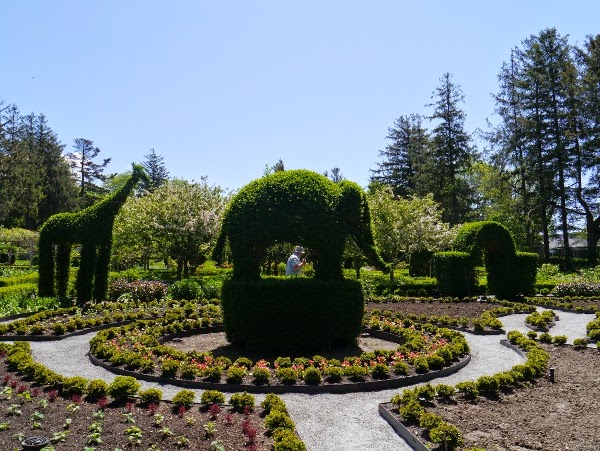One surefire way to beat the January doldrums is to daydream of travels past, and when I look back on our trip to Boston and New England last spring, the day we spent in Newport, RI stands out like a shining memory. That's quite possibly because it was the only sunny day we had the entire trip, but what a day it was. Anticipation heightened our light moods as we drove along the highway from Boston to Newport, eating pastries and blasting 80s music.
The balmy weather showed off the town's charms to perfect effect. We spent a little too much time at Green Animals Topiary Gardens snapping photos and hamming it up with shrubbery before we moved on to exploring the Gilded Age mansions, where we spent hours wandering through one cavernous room after another.
A quick social history lesson about the Newport mansions. During the latter half of the 19th century, America's wealthy industrialists and well-bred families made their vacation homes in Newport, where they knocked down humbler beach houses to build mansions of castle-like proportions. Ironically dubbed "cottages," these structures were built to flaunt wealth and taste, and to throw lavish parties. The Newport summer social season saw its share of well-to-do Americans as well as politicians, foreign dignitaries, and cash-poor European nobility hoping to marry a title-hungry American heiress.
Newport's party heyday was shortlived, however. With the advent of personal income tax, families such as the Vanderbilts could no longer keep all their earnings and fund their lavish lifestyles. Over time, the money needed to hire the servants and throw the parties dwindled and the great houses fell into disrepair. In the 20th century, the Preservation Society of Newport County began campaigning for the preservation of these homes; the descendants of the once wealthy families donated their "cottages" as a tax write-off.
There are ten mansions in all, but in the interest of time we chose to focus on two: The Breakers
, which was the largest of them all, and Rosecliff, which we'd heard was charming. I still shake my head when I think of the Breakers—it was just so immense and extravagant a structure, and the grounds so beautiful. The rooms—ornate, furnished with antiques and custom European-inspired furniture—all blur into one another in my mind, but I do remember the butler's pantry vividly. This one room where the servants lined up banquet dishes to be served, plated food, and stored the china in endless glass cases was two floors high and bigger than a standard Vancouver townhome. A room big enough for a family of four to live in, and it was just used to store china!The boy, who had never been to Europe, was gobsmacked. "Ridiculous," he kept saying. "Ridiculous." Despite the obvious opulence, for me the biggest luxury of the place was the view: The mansion was perched on a huge expanse of green lawn right next to a cliff overlooking the Atlantic Ocean. It was endless blue sea, as far as the eye could see.
Even though we wanted to linger at the Breakers, we forced ourselves to eat a quick lunch and move onto the next mansion, Rosecliff. Rosecliff was much smaller in scale but no less appealing, with its heart-shaped staircase and immaculate grounds and party room. The Robert Redford version of The Great Gatsby was filmed here and the space is still available to rent out for special events such as weddings. From the verdant lawns of Rosecliff we made our way to the Cliff Walk winding its way across the backyards of all the Newport mansions, drinking in that blue, blue Atlantic Ocean view once reserved for the 19th century's one percent.
Gilded Age glamour and Edith Wharton charm aside, Newport feels like a yacht resort town, albeit with more historical buildings and funny little side streets. (How quaintly New England.) We decided to go into town and splurge on dinner: a prime aged steak for him, and a whole lobster for me. This was my first time eating a whole lobster—not just a lobster tail—and wow. The lobster cracker was nearly defeated by the freakishly hard claws. By the time I realized how messy it was going to get, my hands were wrist-deep in lobster stuff and I had to ask the boy to tuck a napkin in my collar to protect my white top. And here's another thing I learned: lobster meat has a lot of white cartilage in it that's not very tasty at all and very hard to tell apart from lobster meat in dim candlelight. After accidentally chewing on cartilage once or twice, I learned to pick out the cartilage—rough and starchy-feeling—from the plump, firm lobster meat.
Looking back on our Newport day, I wouldn't have done it any other way. It was the perfect balance of outdoors time (the topiary garden, the cliff walk), mind-blowing opulence (the Breakers), and romantic charm (Rosecliff). And, a lobster! The fact that we would spend the next couple days in Boston was bittersweet: No more day trips, but we'd get a chance to get to know Beantown a lot better.
















No comments